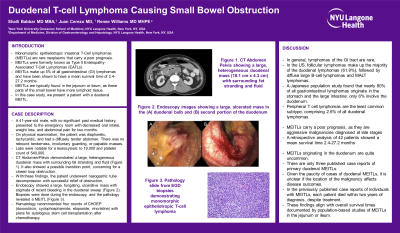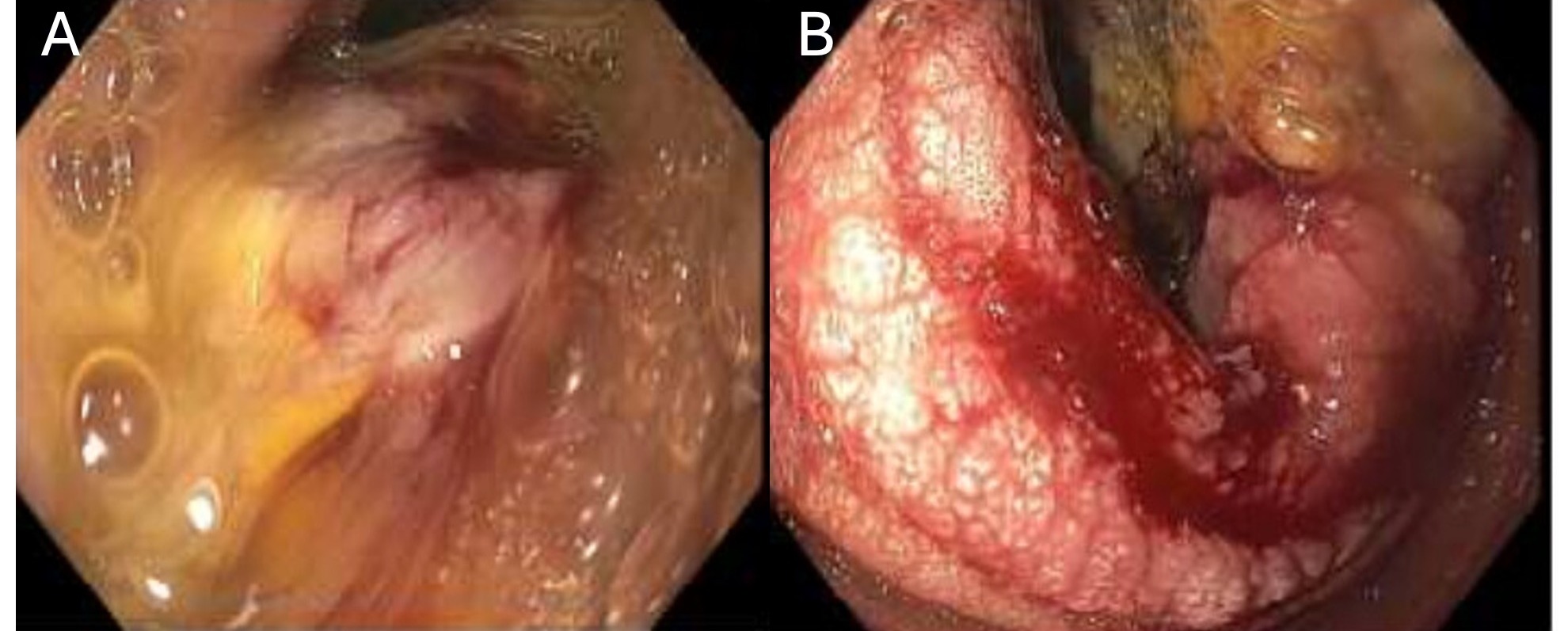Monday Poster Session
Category: Small Intestine
P3232 - Duodenal T-Cell Lymphoma Causing Small Bowel Obstruction
Monday, October 28, 2024
10:30 AM - 4:00 PM ET
Location: Exhibit Hall E

Has Audio
- SB
Shaili Babbar, MD
New York University
Robbinsville, NJ
Presenting Author(s)
Shaili Babbar, MD1, Juan Cerezo, MD2, Renee Williams, MD3
1New York University, Robbinsville, NJ; 2New York University, New York, NY; 3NYU Grossman School of Medicine, North Bergen, NJ
Introduction: Monomorphic epitheliotropic intestinal T-Cell lymphomas (MEITLs) are rare neoplasms that carry a poor prognosis. MEITLs, formerly known as Type II Enteropathy-Associated T-Cell Lymphomas (EATLs), make up 5% of all gastrointestinal (GI) lymphomas and have been shown to have a mean survival time of 2.4-27.2 months. MEITLs are typically found in the jejunum or ileum, as these parts of the small bowel have more lymphoid tissue. In this case study, we present a patient with a duodenal MEITL.
Case Description/Methods: A 41-year-old male, with no significant past medical history, presented to the emergency room with decreased oral intake, weight loss, and abdominal pain for two months. On physical examination, the patient was diaphoretic, tachycardiac, and had a diffusely tender abdomen. There was no rebound tenderness, involuntary guarding, or palpable masses. Labs were notable for a leukocytosis to 19,000 and platelet count of 540,000. CT Abdomen/Pelvis demonstrated a large, heterogeneous duodenal mass with surrounding fat stranding and fluid. It also showed a possible transition point, concerning for a closed loop obstruction. With these findings, the patient underwent nasogastric tube decompression with successful relief of obstruction. Endoscopy showed a large, fungating, ulcerative mass with stigmata of recent bleeding in the duodenal sweep (Figure 1). Biopsies were done during the endoscopy, and the pathology revealed a MEITL. Hematology recommended four rounds of CHOEP (doxorubicin, cyclophosphamide, etoposide, vincristine) with plans for autologous stem cell transplantation after chemotherapy.
Discussion: In general, lymphomas of the GI tract are rare. In the US, follicular lymphomas make up the majority of duodenal lymphomas (61.9%), followed by diffuse large B-cell lymphomas and MALT lymphomas. Peripheral T cell lymphomas are the least common subtype, comprising 2.6% of all duodenal lymphomas.
MEITLs originating in the duodenum are quite uncommon. In fact, there are only three published case reports of primary duodenal MEITLs. Given the paucity of cases of duodenal MEITLs, it is unclear if the location of the malignancy affects disease course or outcomes. In the previously published case reports of individuals with duodenal MEITLs, each patient died within two years of diagnosis, despite treatment. These findings align with overall survival times documented by population-based studies of MEITLs in the jejunum or ileum.

Disclosures:
Shaili Babbar, MD1, Juan Cerezo, MD2, Renee Williams, MD3. P3232 - Duodenal T-Cell Lymphoma Causing Small Bowel Obstruction, ACG 2024 Annual Scientific Meeting Abstracts. Philadelphia, PA: American College of Gastroenterology.
1New York University, Robbinsville, NJ; 2New York University, New York, NY; 3NYU Grossman School of Medicine, North Bergen, NJ
Introduction: Monomorphic epitheliotropic intestinal T-Cell lymphomas (MEITLs) are rare neoplasms that carry a poor prognosis. MEITLs, formerly known as Type II Enteropathy-Associated T-Cell Lymphomas (EATLs), make up 5% of all gastrointestinal (GI) lymphomas and have been shown to have a mean survival time of 2.4-27.2 months. MEITLs are typically found in the jejunum or ileum, as these parts of the small bowel have more lymphoid tissue. In this case study, we present a patient with a duodenal MEITL.
Case Description/Methods: A 41-year-old male, with no significant past medical history, presented to the emergency room with decreased oral intake, weight loss, and abdominal pain for two months. On physical examination, the patient was diaphoretic, tachycardiac, and had a diffusely tender abdomen. There was no rebound tenderness, involuntary guarding, or palpable masses. Labs were notable for a leukocytosis to 19,000 and platelet count of 540,000. CT Abdomen/Pelvis demonstrated a large, heterogeneous duodenal mass with surrounding fat stranding and fluid. It also showed a possible transition point, concerning for a closed loop obstruction. With these findings, the patient underwent nasogastric tube decompression with successful relief of obstruction. Endoscopy showed a large, fungating, ulcerative mass with stigmata of recent bleeding in the duodenal sweep (Figure 1). Biopsies were done during the endoscopy, and the pathology revealed a MEITL. Hematology recommended four rounds of CHOEP (doxorubicin, cyclophosphamide, etoposide, vincristine) with plans for autologous stem cell transplantation after chemotherapy.
Discussion: In general, lymphomas of the GI tract are rare. In the US, follicular lymphomas make up the majority of duodenal lymphomas (61.9%), followed by diffuse large B-cell lymphomas and MALT lymphomas. Peripheral T cell lymphomas are the least common subtype, comprising 2.6% of all duodenal lymphomas.
MEITLs originating in the duodenum are quite uncommon. In fact, there are only three published case reports of primary duodenal MEITLs. Given the paucity of cases of duodenal MEITLs, it is unclear if the location of the malignancy affects disease course or outcomes. In the previously published case reports of individuals with duodenal MEITLs, each patient died within two years of diagnosis, despite treatment. These findings align with overall survival times documented by population-based studies of MEITLs in the jejunum or ileum.

Figure: Figure 1: Endoscopy images showing a large, ulcerated mass in the (A) duodenal bulb and (B) second portion of the duodenum.
Disclosures:
Shaili Babbar indicated no relevant financial relationships.
Juan Cerezo indicated no relevant financial relationships.
Renee Williams: Medtronic – Consultant. Olympus USA – Consultant. Universal Dx – Consultant.
Shaili Babbar, MD1, Juan Cerezo, MD2, Renee Williams, MD3. P3232 - Duodenal T-Cell Lymphoma Causing Small Bowel Obstruction, ACG 2024 Annual Scientific Meeting Abstracts. Philadelphia, PA: American College of Gastroenterology.
